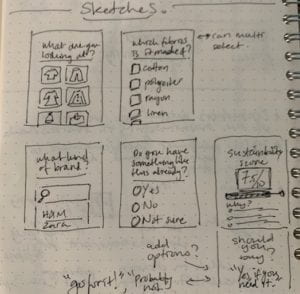Group members: Sam and Tiger
Idea evolution:
The problem that we identified for the design challenge is: How might we provide a “sustainability score” of clothing for consumers to help them make more sustainable fashion choices? Because there are few ways for consumers to learn about the production process of clothes, and also because of most consumers’ lack of knowledge on textiles, it is hard for them to make sustainable decisions when buying them. Therefore, we would like to help with that by designing a WeChat mini program that allows users to scan a tag on a piece of clothing, and then displays a “sustainability score” indicating its level of sustainability. The score would be determined by these factors: the type of clothing, the brand, the textile, and the price. Besides, it could We do realize that as time is limited, we might not be able to build a program that’s fully functional, but the basic feature that it would have is that on receiving input, it gives a roughly calculated score based on that.
Research update:
As part of developing our sustainability score definition, we’ve started looking into some already existing sites that accomplish the same, or very similar thing. For example, Good on You has a directory of brands where they rate how sustainable a brand is. Here is a screenshot of their directory:

If you click into a brand, they provide a rating overview for “planet”, “people”, and “animals”, with a more detailed explanation below. Good on You also provides a page where they describe how they rate: https://goodonyou.eco/how-we-rate/. We will use their guidelines to inform our sustainability score.
We are also exploring The Kering Group’s page on sustainability: https://www.kering.com/en/sustainability/. We are also looking into their environmental P&L tool found here: https://www.kering.com/en/sustainability/environmental-profit-loss/.
Design and development update:
Since we were not so familiar with building a WeChat mini program, we attended the popcorn session that Konrad led on Friday. We learned that its syntax is a bit different from HTML + CSS + JS, but similar enough to understand the basics. On the official WeChat mini program website we found some informative instructions on how to develop a mini program.
We have some initial ideas for the design of the app, but have yet to create mockups and turn it into a prototype. However, since we want to keep the app simple so that it’s easy to use when shopping / on the go, hopefully that won’t take too long(!).

For the prototype, we will likely hard code the scores based on user input. However, the vision is that a user can simply scan a piece of clothing without having to do any manual input and then the program returns a score. (We definitely won’t get around to this version this time around though!)
Next steps:
Our next steps include conducting some more research and then putting together our definition of our own sustainability score. We will also have to design the screens for the MVP mini program. We are aiming to have a prototype ready by next weekend so that we can guerrilla test it at a mall to get some user feedback.